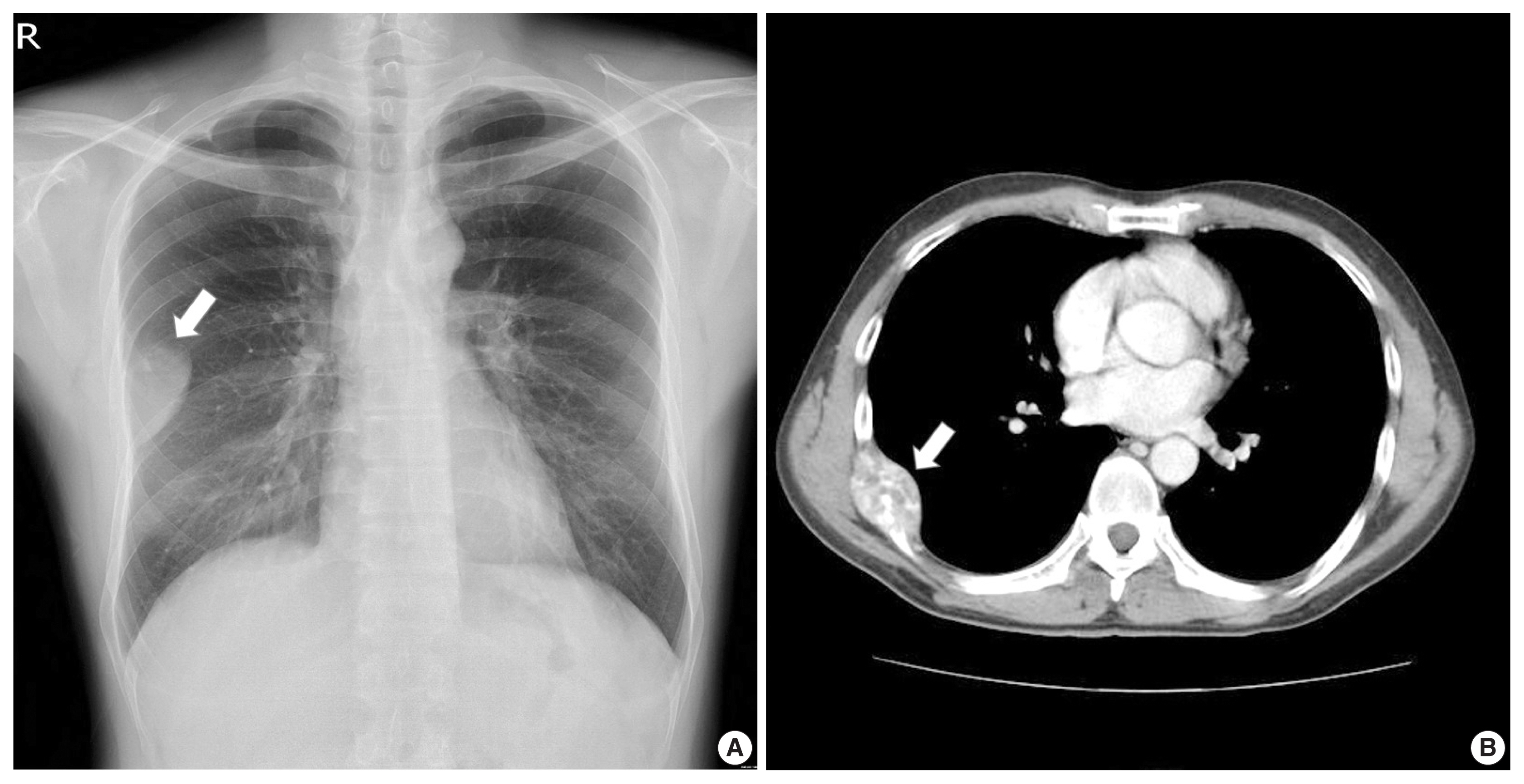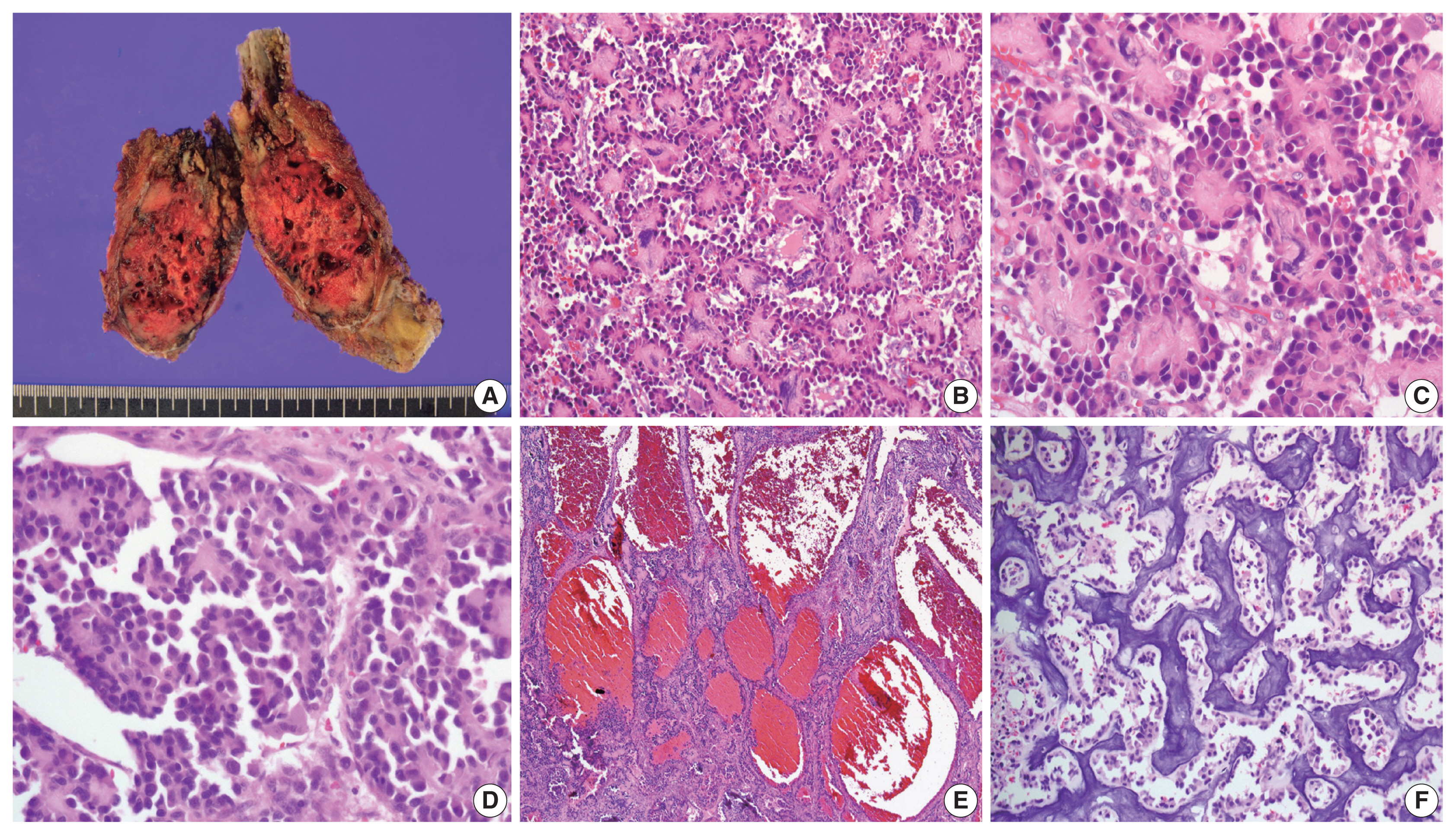Articles
- Page Path
- HOME > J Pathol Transl Med > Volume 55(6); 2021 > Article
-
Case Study
Rosette-forming epithelioid osteosarcoma in the rib: a rare case of location and morphology -
Sun-Ju Oh

-
Journal of Pathology and Translational Medicine 2021;55(6):406-409.
DOI: https://doi.org/10.4132/jptm.2021.06.22
Published online: August 3, 2021
Department of Pathology, Kosin University College of Medicine, Busan, Korea
- Corresponding Author: Sun-Ju Oh, Department of Pathology, Kosin University College of Medicine, 262 Gamcheon-ro, Seo-gu, Busan 49267, Korea, Tel: +82-51-990-6333, Fax: +82-51-990-3080, E-mail: 10highpowerfield@gmail.com
© 2021 The Korean Society of Pathologists/The Korean Society for Cytopathology
This is an Open Access article distributed under the terms of the Creative Commons Attribution Non-Commercial License (https://creativecommons.org/licenses/by-nc/4.0) which permits unrestricted non-commercial use, distribution, and reproduction in any medium, provided the original work is properly cited.
Abstract
- The rib is an unusual location for osteosarcoma and is reported in only 2% of all cases. The major histological variants of osteosarcoma are osteoblastic, chondroblastic, and fibroblastic, with a few rare variants including one epithelioid type. This report describes a 44-year-old male with an osteolytic mass in the right seventh rib. Histological examination revealed osteosarcoma with unique features of epithelioid appearance and rosette structures. To the best of our knowledge, this is the first reported case of a rosette-forming osteosarcoma of the rib that showed epithelioid morphology. Despite successful surgery, the patient’s prognosis was poor because this malignancy had an unusual location within the axial skeleton and was a rare histological variant.
- A 44-year-old male presented with a mass in the right posterior thorax. He reported intermittent upper back pain for the 6 months prior to admission. An initial chest radiograph showed a nonhomogeneous mass that involved the posterolateral aspect of the right 7th rib, and contrast-enhanced chest computed tomography (CT) indicated an ill-defined osteolytic lesion with coarse calcification (Fig. 1). Overall image analysis suggested a malignant bone tumor, including chondrosarcoma. The patient underwent wide surgical excision of the rib with tumor-free margins.
- Gross examination revealed resected bone with a 6-cm-sized hemorrhagic mass with cortical disruption (Fig. 2A). Microscopically, the tumor was arranged in a trabecular or rosette-like growth pattern that contained a fibrillar matrix in the center (Fig. 2B, C). Higher magnification exhibited epithelioid tumor cells with a plasmacytoid feature of eccentrically located nuclei and an abundant cytoplasm (Fig. 2C, D). The nuclei showed a clumped chromatin pattern, and each contained 1 or 2 prominent nucleoli. Mitoses were frequent, up to 12 per 10 high-power fields. An area of well-defined nests was identified, whereas blood-filled cystic spaces exhibited telangiectatic features (Fig. 2E). An irregularly interconnected coarse trabecular pattern of immature osteoid deposition was obvious throughout the tumor (Fig. 2F). For immunohistochemical panels, the neoplastic cells stained negatively for cytokeratin AE1/AE3, leukocyte common antigen, CD138, CD99, synaptophysin, desmin, and CD34, with the only exception of a positive reaction for vimentin. The final histologic diagnosis was a rosette-forming epithelioid osteosarcoma.
- The postoperative systemic workup did not reveal metastasis, and the patient was treated with adjuvant radiotherapy for prophylactic purposes. After one year of follow-up, however, recurrence was noted on the adjacent ribs and chest wall, for which the patient underwent palliative surgery followed by six cycles of adjuvant chemotherapy that consisted of doxorubicin and cisplatin. Tumor progression continued with multiple metastases to both lungs and the liver, and the patient died four and a half years after initial diagnosis.
CASE REPORT
- Primary OSA of the ribs is uncommon, and accounting for only 40 (2%) of the total 1,952 cases of OSA reported in the largest series; to date, very few cases have been reported [1–5]. Most of the cases that affect the ribs occurred in patients during their fourth decade, which was late compared to cases of the long bone, which primarily occur in the second decade. The major histological variants of conventional OSA are subdivided as osteoblastic, chondroblastic, and fibroblastic, while a few other variants are classified as giant cell-rich, osteoblastoma-like, and clear cell [1]. Scranton et al. first reported the rare epithelioid OSA subtype [6]. Several subsequent reports have described cases of epithelioid OSA that affect long bones and the lumbar spine, maxilla, and mandible [7–10]. Only one epithelioid OSA that originated in the ribs was reported prior to this case [11]. In one of these epithelioid cases, tumor cells showed various patterns of sheet, alveolar, acinar, trabecular, organoid, hemangiopericytoma-like, and rosette-like appearances [9]. Rosette-forming OSA was illustrated in only two previous studies [8,9]. In the two studies, Okada et al. found a rosette-like structure in 16 of 280 cases of OSA, which corresponded with a rate of 5.7% [9].
- Histopathological differential diagnosis in epithelioid tumors of the rib are comprised of various malignant neoplasms including metastatic carcinoma, malignant melanoma, and any kind of malignant mesenchymal tumor with an epithelioid appearance such as a fibrosarcoma, leiomyosarcoma, and an undifferentiated sarcoma. Although immunohistochemistry is helpful for differentiation, the tissue samples must be carefully examined to identify malignant osteoid formation by tumor cells, which is pathognomonic for OSA. Metaplastic bone formations and calcifications are relatively common in many benign and malignant tumors, but only lace-like osteoid formation by malignant cells is important in the differential diagnosis.
- Reported outcomes of patients with OSA indicated traumatic improvements after wide excision and multi-agent chemotherapy [1]. This strategy of extensive surgical resection and adjuvant chemotherapy are also effective in OSA of the ribs and increased the likelihood of relapse-free survival [2]. Another study, however, indicated that there was no apparent difference in survival rates between patients who underwent surgery alone and those who underwent both surgery and chemotherapy [4]. Surgical resection should include the entire thickness of the chest wall with a wide margin, including the adjacent ribs, intercostal muscles, pleura, and vertebrae. After resection, large chest wall defects need to be covered with tissue flaps or mesh material [4].
- The prognosis of OSA in the axial skeleton, including the rib, is generally poorer than results reported for cases in the extremity [1]. The 5-year survival rate for patients with rib OSA was much lower, at 27%, despite multimodal chemotherapy and aggressive surgery, compared to the higher 65%–75% survival rate in patients with OSA in an extremity [4]. Okada et al. [9] reported that rosette-forming OSA is more aggressive than other histological variants; the 5-year survival rate was 15% compared to 45% for OSA without rosettes. In addition, 75% of patients with rosette characteristics died of multiple lung metastases despite extensive surgery with wide surgical margins and systemic chemotherapy [9].
- In conclusion, this is the first report of a rosette-forming epithelioid OSA that involved the rib. This case illustrates the unusual morphological features. Because this OSA is a rare subtype and associated with a poor prognosis, additional information regarding proper treatment is needed.
DISCUSSION
Ethics Statement
This study was approved by the institutional review board (IRB) of Kosin University Gospel Hospital with a waiver of informed consent (IRB No. 2018-01-020).
Availability of Data and Material
The datasets generated or analyzed during the study are available from the corresponding author on reasonable request.
Code Availability
Not applicable.
Conflicts of Interest
The authors declare that they have no potential conflicts of interest.
Funding Statement
No funding to declare.


- 1. Unni KK, Inwards CY. Dahlin’s bone tumors. 6th ed.Philadelphia: Lippincott Williams & Wilkins, 2010; 122-57.
- 2. Chattopadhyay A, Nagendhar Y, Kumar V. Osteosarcoma of the rib. Indian J Pediatr 2004; 71: 543-4. ArticlePubMedPDF
- 3. Ikeda H, Takeo M, Kayata H, Mikami R, Nakamoto Y, Yamamoto M. A case of rapidly growing osteosarcoma of the rib. Ann Thorac Cardiovasc Surg 2014; 20(Suppl):521-4. ArticlePubMed
- 4. Deitch J, Crawford AH, Choudhury S. Osteogenic sarcoma of the rib: a case presentation and literature review. Spine (Phila Pa 1976) 2003; 28: E74-7. PubMed
- 5. Mohanty S, Inchara YK, Crasta JA, Ananthamurthy A. An unusual case of primary osteosarcoma of the rib in an adult. Indian J Med Paediatr Oncol 2010; 31: 18-20. ArticlePubMedPMC
- 6. Scranton PE Jr, DeCicco FA, Totten RS, Yunis EJ. Prognostic factors in osteosarcoma: a review of 20 year’s experience at the University of Pittsburgh Health Center Hospitals. Cancer 1975; 36: 2179-91. ArticlePubMed
- 7. Kramer K, Hicks DG, Palis J, et al. Epithelioid osteosarcoma of bone: immunocytochemical evidence suggesting divergent epithelial and mesenchymal differentiation in a primary osseous neoplasm. Cancer 1993; 71: 2977-82. ArticlePubMed
- 8. Carlos-Bregni R, Contreras E, Hiraki KR, Vargas PA, Leon JE, de Almeida OP. Epithelioid osteosarcoma of the mandible: a rare case with unusual immunoprofile. Oral Surg Oral Med Oral Pathol Oral Radiol Endod 2008; 105: e47-52. ArticlePubMed
- 9. Okada K, Hasegawa T, Yokoyama R. Rosette-forming epithelioid osteosarcoma: a histologic subtype with highly aggressive clinical behavior. Hum Pathol 2001; 32: 726-33. ArticlePubMed
- 10. Kaveri H, Rekha K, Punnya VA. Epithelioid osteosarcoma of the maxilla: report of an unusual case. Br J Oral Maxillofac Surg 2009; 47: 143-5. ArticlePubMed
- 11. Kuwabara H, Fujita K, Yuki M, Goto I, Hanafusa T, Shibayama Y. Cytokeratin-positive rib osteosarcoma metastasizing to the small intestine. Indian J Pathol Microbiol 2014; 57: 109-12. ArticlePubMed
REFERENCES
Figure & Data
References
Citations

- Clinicopathological correlations and prognostic insights in osteosarcoma: a retrospective analysis
Ştefan Adrian Niculescu, Alexandru Florian Grecu , Alex Emilian Stepan , Mădălina Iuliana Muşat , Aritina-Elvira Moroşanu , Tudor Adrian Bălşeanu , Michael Hadjiargyrou , Dan Cristian Grecu
Romanian Journal of Morphology and Embryology.2025; 65(4): 723. CrossRef
 PubReader
PubReader ePub Link
ePub Link-
 Cite this Article
Cite this Article
- Cite this Article
-
- Close
- Download Citation
- Close
- Figure



 E-submission
E-submission




